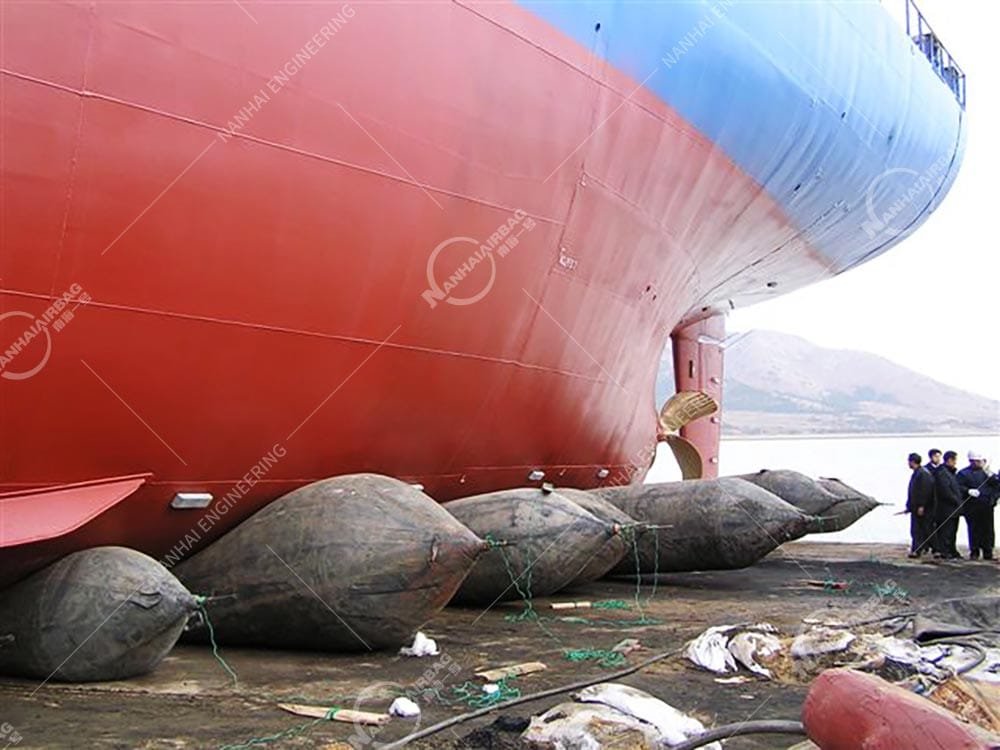Bagaimana Fender Laut Pelindung Laut Mengurangi Kerusakan Akibat Benturan
11/14/2025Why Do Some People Choose Colored Pneumatic Rubber Fenders?
11/18/2025Ship Launching Inflatable Roller: A Practical Guide for Safe and Efficient Vessel Launching
Launching a vessel is always a high-pressure moment for any shipyard. You want everything to run smoothly, safely, and without damaging the hull. That’s why more and more shipyards are switching from permanent slipways to ship launching inflatable rollers. They offer flexibility, strong support, and impressive cost savings—especially for medium and large vessels.
In this guide, we’ll walk through how inflatable rollers work, how to choose the right ones, and why many shipyards trust NANHAI for reliable roller solutions.
What Is a Ship Launching Inflatable Roller?
A ship launching inflatable roller is a heavy-duty marine airbag used to move and launch vessels from land into the water. Instead of relying on fixed rails or a traditional slipway, these rollers act like movable, high-strength cushions that carry the vessel’s weight and help it roll forward smoothly.
A typical roller includes:
- Multiple layers of reinforced rubber
- High-strength synthetic cords
- A tough outer layer designed for abrasion, impact, and repeated use
Compared with older launching methods, they are easier to set up, reusable, and suitable for different launch sites.

How Ship Launching Rollers Work During Launching
Inflatable rollers use internal air pressure to create strong, stable support under the hull. As the vessel moves forward, each roller rotates and transfers the load to the next roller in line.
This process allows:
- Smooth movement
- Reduced hull stress
- Controlled speed
- Better load distribution
With the right arrangement and roller spacing, even large ships can be launched safely.
Key Advantages of Using Ship Launching Rollers
Shipyards choose ship launching rollers because they offer real-world benefits:
1. Big Cost Savings
No need to build a concrete slipway or install heavy rails. One set of rollers can serve many launches.
2. Strong Load Capacity
Modern ship launchingrollers can handle thousands of tons with proper pressure control.
3. Flexible and Reusable
Suitable for steel ships, wooden boats, fishing vessels, barges, and more.
4. Fast Setup
Rollers can be positioned, inflated, and used within hours.
5. Works in Many Locations
Dirt, sand, concrete—almost any surface can be prepared for launching.
Choosing the Right Ship Launching Inflatable Roller
The correct roller selection is essential for a safe launch. Consider:
- Roller diameter (bigger rollers = higher support + easier rolling)
- Roller length (should cover most of the vessel’s beam)
- Number of rollers required
- Vessel weight and dimensions
- Ground type and launch slope
- Tidal conditions
Professional suppliers like NANHAI can calculate exact roller specs for your project.
Step-by-Step Launching Process Using Inflatable Rollers
A safe launch usually includes:
1. Ground Preparation
Clear debris, level the path, compact loose soil if needed.
2. Roller Positioning
Place rollers under the hull with even spacing.
3. Lifting the Vessel
Use jacks or cranes to place the vessel onto the rollers.
4. Rolling Movement
Tow the vessel forward in a controlled manner.
5. Entering the Water
Monitor speed and alignment to prevent yaw or drift.
6. Roller Retrieval
Once the vessel floats, remove, clean, and store the rollers.
Safety Tips and Best Practices
- Check roller pressure before every operation.
- Avoid sharp objects on the launching path.
- Monitor roller movement during towing.
- Never overload rollers beyond their rated capacity.
- Only allow trained staff to operate towing equipment.
Common Problems and How to Avoid Them
| Masalah | How to Avoid / Fix |
|---|---|
| Uneven ground | Level or compact the surface before launching |
| Too few rollers | Calculate roller quantity based on actual weight |
| Air leakage | Inspect for cuts and replace valves if needed |
| Vessel misalignment | Use guide ropes and controlled towing speed |
Other Uses of Inflatable Rollers
Ship launching airbags are versatile. Besides launching, they can also be used for:
- Ship hauling (bringing vessels ashore)
- Moving heavy structures
- Lifting large industrial equipment
- Coastal construction support
Why Choose NANHAI Ship Launching Inflatable Rollers?
NANHAI supplies high-strength inflatable rollers designed for demanding shipyard operations. Our products feature upgraded rubber compounds with superior abrasion resistance, excellent performance under heavy loads, and long service life, even in harsh environments.
FAQs About Ship Launching Inflatable Rollers
1. How long do inflatable rollers last?
With proper maintenance, 5–10 years depending on workload.
2. Can they be used on uneven ground?
Yes, but the surface should be cleared and reasonably leveled.
3. How many rollers do I need?
It depends on the vessel weight, beam width, and launch slope. NANHAI can calculate for you.
4. Are rollers safe for steel hulls?
Absolutely. The rubber structure protects the hull from stress and impact.
Contact NANHAI for a Customized Quotation
To give you an accurate quotation and roller configuration, please provide the following information:
- What type of vessel will be launched?
- Total length of the vessel (LOA).
- Maximum width (beam) of the vessel.
- Actual launching weight of the vessel.
- Vessel’s DWT (if available).
- What type of ground is the vessel sitting on? (Dirt, concrete, sand, etc.)
- Water depth at the point where the vessel first enters the water.
- Slipway angle on land (in degrees).
- Low and high tide schedule at your site.
- Working height — the height of the block stands supporting the vessel.
- Distance from the bottom of the propeller to the water level.
- Distance from the stern to the water entry point.
- And if possible, please send photos of the launching area for better evaluation.
We will use this information to prepare the safest and most cost-effective launching plan for you.
